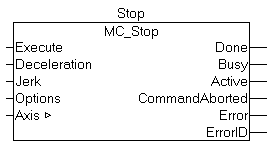MC_Stop

MC_Stop stops an axis with a defined deceleration ramp and locks it against other motion commands. The function block is therefore suitable for stops in special situations, in which further axis movements are to be prevented.
Notice | |
At the same time the axis is blocked for other motion commands. The axis can only be restarted once the Execute signal has been set to FALSE after the axis has stopped. A few cycles are required to release the axis after a falling edge of Execute. During this phase the Busy output remains TRUE, and the function block has to be called until Busy becomes FALSE. |
Notice | |
The locking of the axis is canceled with an MC_Reset. |
Alternatively, the axis can be stopped with MC_Halt without locking. MC_Halt is preferable for normal movements.
Motion commands can be applied to coupled slave axes, if this option was explicitly activated in the axis parameters. A motion command such as MC_Stop then automatically leads to decoupling of the axis, after which the command is executed.
Inputs
VAR_INPUT
Execute : BOOL;
Deceleration : LREAL;
Jerk : LREAL;
Options : ST_MoveOptions;
END_VAR
Execute | The command is executed with a rising edge at input Execute. |
Deceleration | Deceleration (≥0). If the value is 0, the deceleration parameterized with the last move command takes effect. For safety reasons |
Jerk | Jerk (≥0). If the value is 0, the jerk parameterized with the last Move command takes effect. For safety reasons |
Options | Currently not implemented - The data structure Options includes additional, rarely required parameters. The input can normally remain open. |
Outputs
VAR_OUTPUT
Done : BOOL;
Busy : BOOL;
Active : BOOL;
CommandAborted : BOOL;
Error : BOOL;
ErrorID : UDINT;
END_VAR
Done | The Done output becomes TRUE, if the axis was stopped and has come to a standstill. |
Busy | The Busy output becomes TRUE when the command is started with Execute and remains TRUE as long as the command is processed. If Busy becomes FALSE again, the function block is ready for a new order. |
Active | Active indicates that the function block is controlling the axis. |
CommandAborted | Becomes TRUE, if the command could not be fully executed. |
Error | Becomes TRUE if an error occurs. |
ErrorID | If the error output is set, this parameter supplies the error number. |